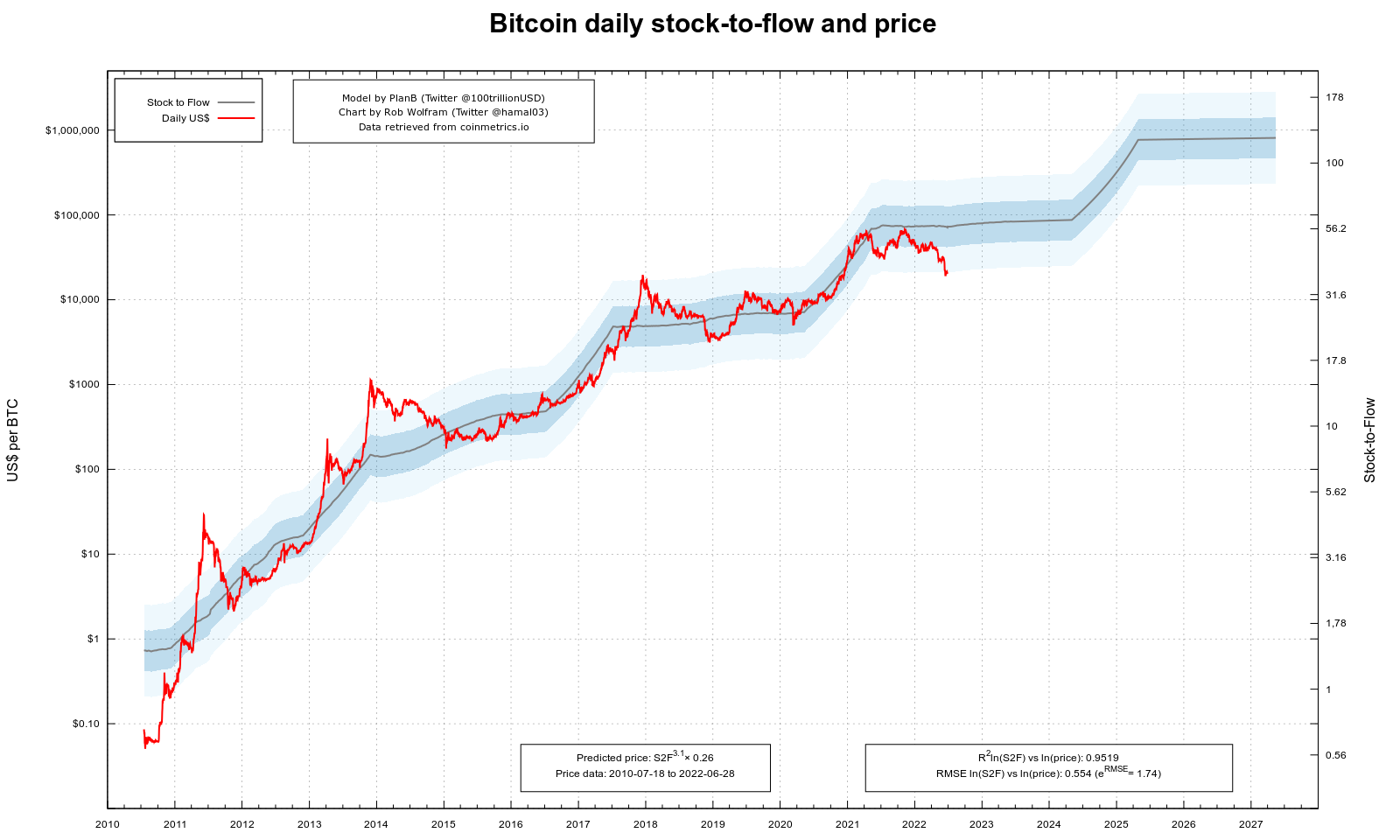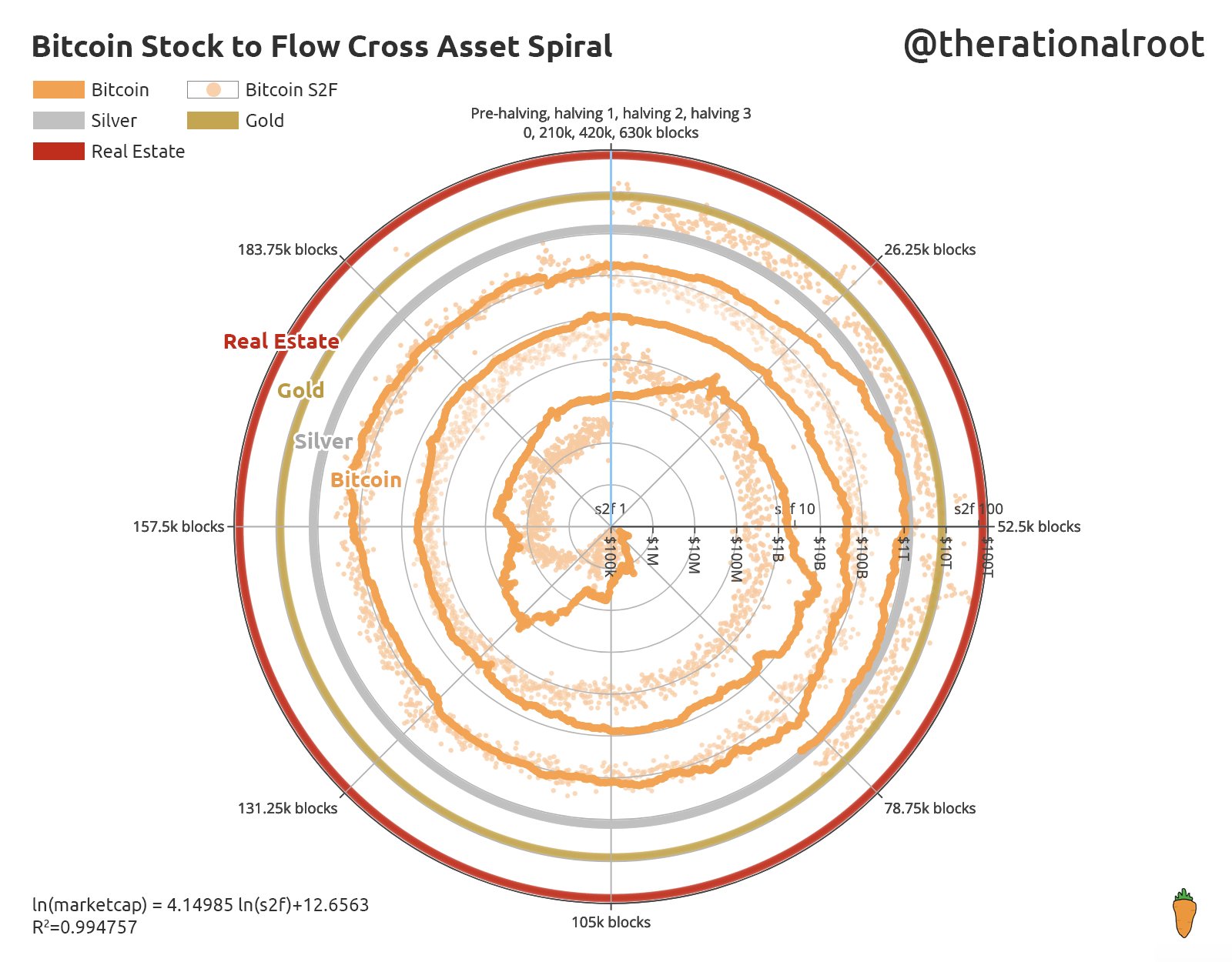As with securities and precious metals, various methods for valuing the digital asset became established for Bitcoin. Stock-to-flow (S2F), one of the best-known pricing models, was developed for physical gold, for example, and adapted to "digital gold". What is the status of these forecasts?
The stock-to-flow (S2F) ratio was first described by Hungarian Professor Fekete in 1997. The stock of a precious metal is put in relation to the annual production. The higher the stock-to-flow ratio, the lower the impact of a supply shock on the price of the precious metal. Gold first established itself as a store of value because it was rare. However, gold owes its triumph over other rare precious metals to the high S2F ratio, as this has led to higher price stability compared to other precious metals such as silver, platinum or palladium.
S2F bitcoin price prediction declared invalid
On June 18, 2022, the price of Bitcoin (BTC) plummeted to a low of $17,600, breaking the lower bound of the S2F model for the first time. This has questioned the validity of the mathematical model. The model proposed by Plan B assumes that the bitcoin price can be roughly forecast and is on a steady upward path. Every four years, this calculates an almost tenfold return. The mathematical model compares the existing Bitcoin supply (the total amount available) with the new production flow (the amount mined in a given year).
Moreover, the model predicts that the bitcoin price would reach the $100,000 mark by the end of 2021 and be well on its way to the $1 million mark by 2026. With the price hitting a two-year low below $20,000, an increasing number of market participants are accusing the Plan B model of selling false hope to the masses of retail investors.

Rob Wolfram, a bitcoin maximalist, constantly compares bitcoin prices to Plan B's S2F model. The dark blue area represents one standard error of the predicted price, and the light blue area represents two standard errors. In the chart above, the predicted price is extended into the future to January 1, 2027.
The S2F model was already considered invalid by Rob when the Bitcoin price failed to reach the projected $100,000 by the end of 2021. However, the analyst continued to believe in the model, arguing that Bitcoin is either extremely undervalued and will soon recover or the stock-to-flow model will be "less useful" in the future. This was probably confirmed with the low of the last few weeks.
The limitations of the stock-to-flow model
In the past, critics have pointed to several reasons for the limitations of the model. The assumption that scarcity or supply is the only driver of value seems most relevant. The influence of demand is not considered because this ignores other key price drivers.
The relationship between supply and demand is one of the most fundamental theories about the price of an asset. When supply exceeds demand, prices fall and vice versa. The S2F model disregards the impact of demand for Bitcoin, overlooking unexpected events such as an economic collapse or Black Swan event. The coming weeks will show whether the break was merely an outlier.
Further models for price prediction
Timothy Peterson, Global Macro Manager at Cane Island Alternative Advisors, wrote a paper in 2017 analyzing how Metcalfe's Law has affected the bitcoin price. According to Metcalfe's Law, the value of a network is equal to the number of users squared. As long as Bitcoin's adoption rate grows linearly, the price and value of the network grow exponentially along with it. Using the law, Petersen predicted a bitcoin price of $100,000 by January 2024. That's not much higher than the all-time high of $68,000. However, Petersen has also predicted that the Bitcoin price will reach a peak of $1 million by March 2028.

Twitter user "Root's" HODL model hypothesis sees the percentage of illiquid supply in circulating supply increasing parabolically as Bitcoin's scarcity should steer investor behavior toward store of value as the predominant use case. As a result, illiquid supply will approach 80% of circulating supply by 2036. Future halvings of lower supply will only exacerbate this divergence.
In a very broad model, the Bitcoin long term power law, Bitcoin still seems to be on course. The current support is seen at just above $13,000.

As always, the logic of such a chart and the assumptions derived from it depend on BTC's past performance being an indicator of the future. This is always the case when relying on any kind of linear regression. Increased regulations globally, an expanded war, sanctions, and recession concerns cannot and are not accounted in various models. Such unforeseen events can drastically change this behavior in the future, so one should not take the price predictions of these models as gospel.




